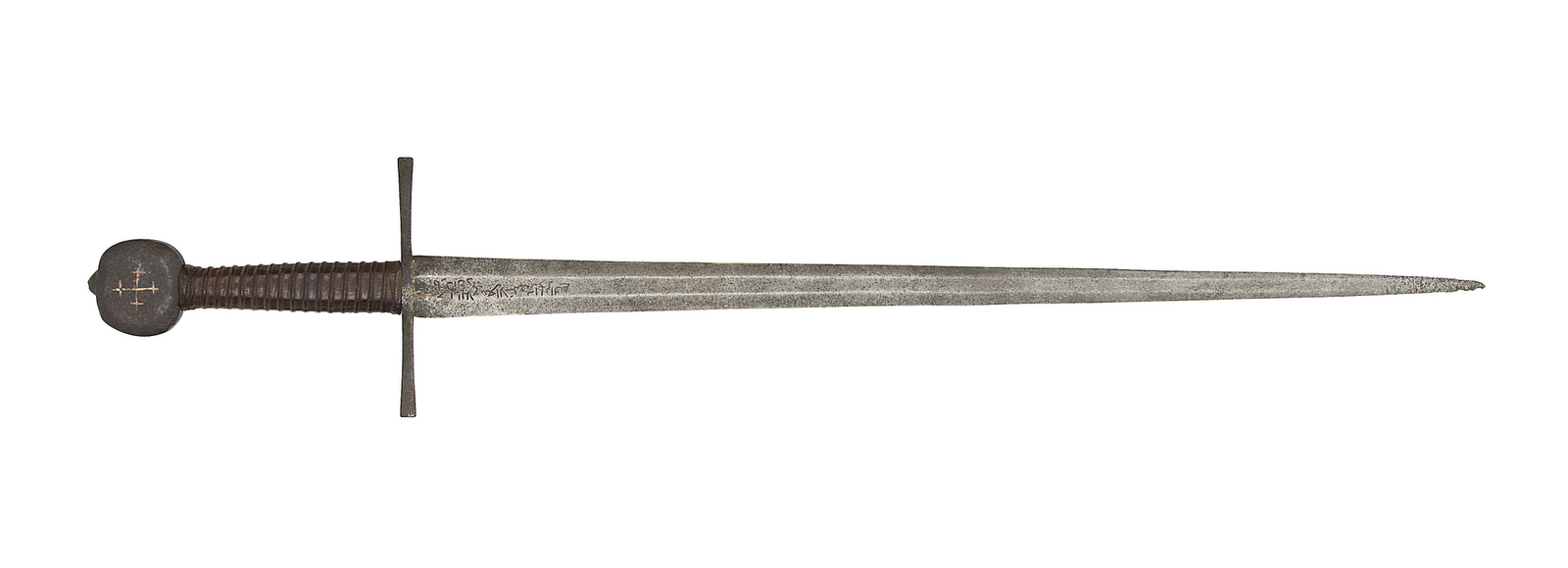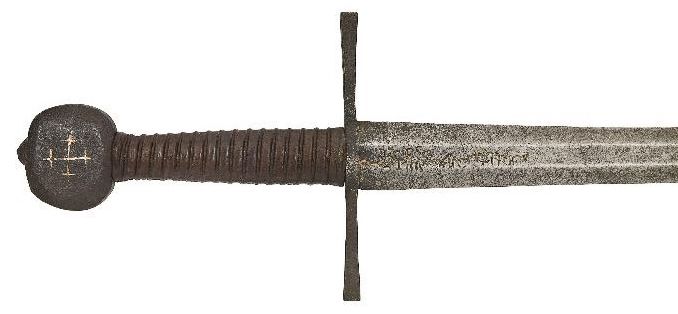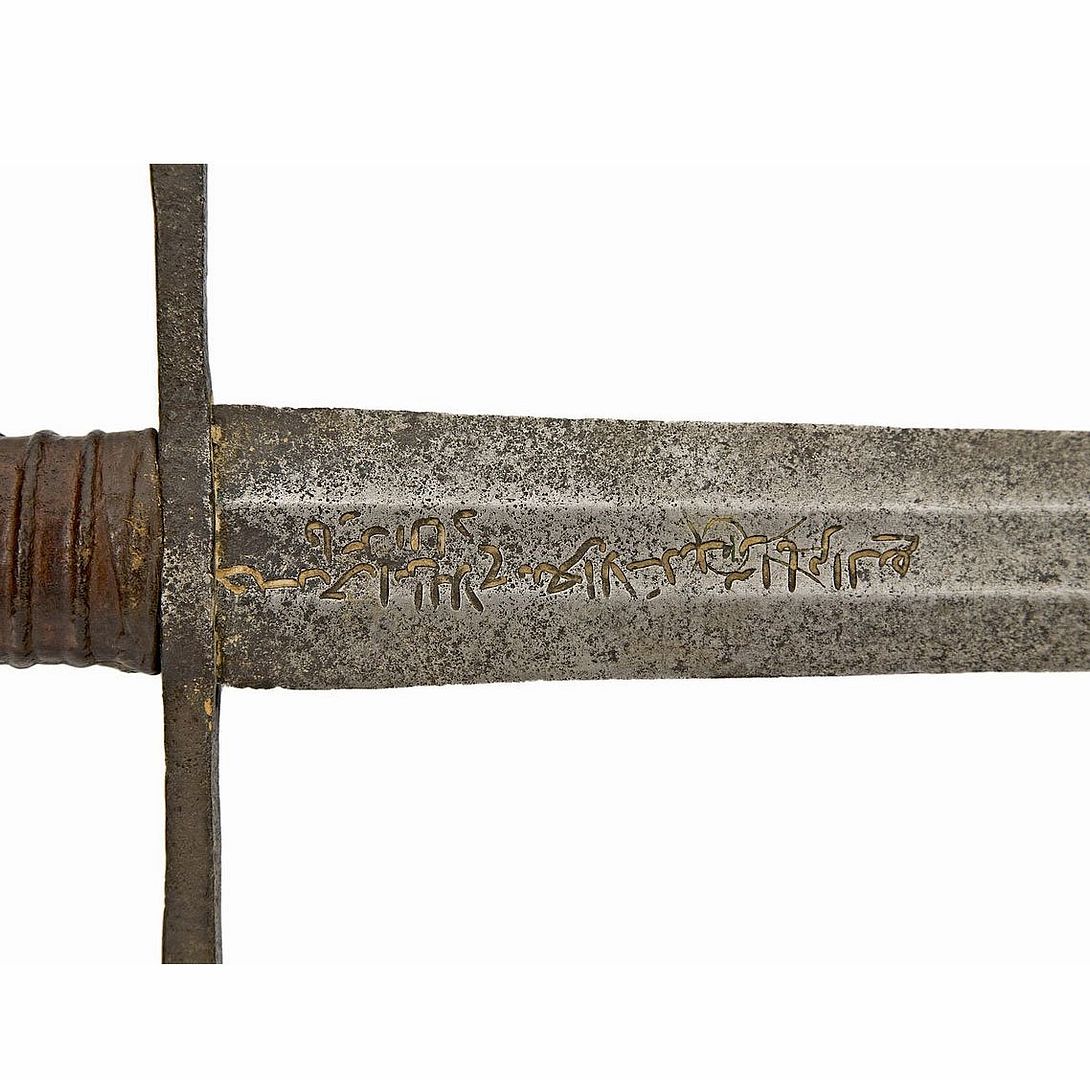Oakeshott Type XVII Sword from Mamluke Arsenal at Alexandria
Aug 9, 2013 12:51:32 GMT
Post by Jack Loomes on Aug 9, 2013 12:51:32 GMT




Rare medieval Crusader sword captured from Mamluk arsenal in Alexandria during last Crusade for sale at Bonhams in London…
A rare medieval sword taken from the Mamluk Arsenal at Alexandria during the last Crusade in the second half of the 14th Century is the top item in Bonhams sale of Antique Arms and Armor on November 28th in Knightsbridge. The sword is estimated to sell for £40,000 to £60,000.
This Italian-made sword was given as a gift to the Mamluk rulers of Alexandria by the Christian ruler of Cyprus and Jerusalem, King Peter I as part of a gift sealing a treaty. The sword was then forcibly taken back into Christian hands during the last Crusade’s victory over the city of Alexandria. Consequently the sword symbolizes the history of the time when Christians and Muslims fought for dominance in the eastern Mediterranean.
King Peter I, the King of Cyprus and Jerusalem, launched the last Crusade in 1362 against the Muslim Mamluk Empire in the region. A fleet set out from Cyprus and proved victorious, taking the city of Alexandria with immense amounts of plunder returned to Cyprus, including this sword. Such was the treasure and weapons taken from the captured city that many of the overloaded ships had to jettison cargo.
David Williams, Head of Bonhams Antique Arms and Armor Department, says: “The fascination of this sword is that it has survived some six centuries having been gifted by a Christian King to a Muslim ruler and kept in the famed Alexandrian armory and then taken by force by Crusaders and returned to Europe. It is a remarkable survivor of the Crusader period.”
The sword has a flat tapering double-edged blade 92.5 cm. long and overall with the hilt 115.7cm. The weapon bears an inscription that reads: ‘Hubs Khazain al-Silah bi thughri al-Iskandariyya ayyam al-Sayfi Faris al [...d.]‘, ‘Donation to the armory in the frontier city of Alexandria in the days of al-Sayfi Faris al- [Muhammadi]. Amir Faris was an inspector in 840H, corresponding to 1436-7 AD. Only three other swords appear to be recorded inscribed in the name of the Amir Faris. One in a private charitable foundation, another in Leeds Castle, Kent and the other in the Military Museum at Istanbul.
This historic sword was acquired by the late owner and arms collector, E.A. Christensen of Copenhagen, in exchange for a Swedish sword from Major John Lindgreen of Malmoe. Lindgreen had bought the sword at an unknown date from the dealer Lundgreen of Stockholm
The sword will go on sale on the 28th November in London, Knightsbridge. Other items from the collection of E.A. Christensen will be on sale as well, although most of this remarkable collection was absorbed into the National Museum in Copenhagen. Catalogue not available before
With flat tapering double-edged blade of flattened hexagonal section with a wide shallow fuller extending over half its length on both sides, the forte on both sides incised with a comet-shaped mark retaining traces of latten, and on one side with inscriptions in naskh script, the hilt comprising straight quillons of rectangular section widening towards the tips, later cord-bound leather-covered grip, and large slightly compressed chamfered wheel pommel with rounded button and inlaid on each side with a cross potent in copper and latten (some pitting overall, particularly at the point)
92.5 cm. blade, 115.7 cm. overall
Sold for £163,250 inc. premium
Provenance:
Acquired by the late owner in exchange for a Swedish sword from Major John Lindgreen of Malmoe. Lindgreen had bought the sword at an unknown date from the dealer Lundgreen of Stockholm
Literature:
Ada Bruhn Hoffmeyer, To riddersværd i en dansk privatsamling, 1952, p. 21 onwards, fig. 1; idem, Middelalderens tveæggede Sværd, 1954, vol. I, pp. 61 and 191, and vol. II, pp. 17 and 94, pl. 20e
Ewart Oakeshott, The Sword In The Age Of Chivalry, 1964, p. 67, pl. 30B
Hoffmeyer, cat. no. 57, pp. 47, 77, 82 and 84, figs. 9 and 18
Ewart Oakeshott, Records Of The Medieval Sword, 1991, p. 163, XVIII.5
See also E. Combe and A.F.C. de Cosson, 'European Swords with Arabic Inscriptions from the Armoury of Alexandria', Bulletin de la Société Royale d'Archèologie d'Alexandrie, n.s. IX (1937), pp. 233f., no. III; David Oliver, 'Some European Knightly Swords from the Arsenal of Alexandria', The Sixteenth Park Lane Arms Fair Guide, 1999, pp. 13-24; Clive Thomas, 'A Distinctive Group of Swords from the Arsenal of Alexandria', ibid, 2003, pp. 29-44; idem, 'The Medieval Swords of Leeds Castle', ibid, 2005, pp. 10-29; Stuart W. Pyhrr, 'The Ottoman Arsenal in Hagia Eirene: Some Early Photographs and Visitors' Accounts', ibid, 2007, pp. 29-46; Clive Thomas, '"Father of Victory" Pious donations of European swords to The Arsenal of Alexandria during the reign of the Sultan al-Mu'ayyad Shaykh', ibid, 2008, pp. 17-38; idem, 'Notes on a small group of swords from the Arsenal of Alexandria', ibid, 2009, pp. 23-42; and idem, '"King of Emirs" Pious donations of European swords to the Arsenal of Alexandria during the time of the Viceroy Sayf al-din Aristay', ibid, 2011, pp. 15-36
The inscription: 'Hubs Khazain al-Silah bi thughri al-Iskandariyya ayyam al-Sayfi Faris al [...d.]', reads in translation: 'Donation to the armoury in the frontier city of Alexandria in the days of al-Sayfi Faris al- [Muhammadi]
Only four other swords appear to be recorded inscribed in the name of the Amir Faris. One in a private charitable foundation, another in Leeds Castle, Kent, another in the Military Museum at Istanbul, and the other, with a partly legible inscription, sold at Sotheby's London, Arts of the Islamic World, 6 October 2010, lot 249, (£97,250 including premium). See David Oliver (1999), Clive Thomas (2005) above, and Ludvik Kalus, Donations Pieuses d'Epées Mediévales à l'Arsenal d'Alexandrie', Revue des Etudes Islamiques, vol. L, Paris, 1982, pp. 1-122
Amir Faris was an inspector in 840 A.H., corresponding to 1436-7 A.D.
For more information see this extract from Records of the Medieval Sword by Ewart Oakeshott on Type XVII as it features this specific sword: sword-site.com/thread/175/oakeshott-type-records-medieval-sword
Source: www.bonhams.com/auctions/19796/lot/78/
Source ii: www.medievalhistories.com/crusader-sword/

.png?width=1920&height=1080&fit=bounds)